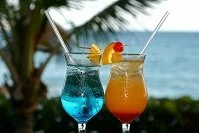Dining Etiquette
Generally speaking, dining in Barbados is an informal affair, but some nice restaurants, and for business you should still dress up and bring your best etiquette. No matter the occasion though, the people of Barbados are quite forgiving of cultural mishaps and dining mistakes, but do your best to follow their protocol.
Arrive on time to meals and let your host seat you. There are usually seating rules, especially in homes and often times couples will be separated to encourage greater conversation. Your meal may begin with a drink and the word "cheers," or it may simply begin with the food, but again your host will indicate when you may begin eating.
If in a home you are expected to try everything offered, but food is usually served family style so you may take less of anything that may not be as appetizing to you. As you eat, use the continental style (knife in the right hand, fork in the left) and keep your hands within sight by resting your wrists on the edge of the table. When you are finished eating, put your fork and knife down together on the right side of your plate. Before you do that though, try to finish all the food on your plate.
If dining in a restaurant, the inviter is expected to pay for everyone present and if you are the guest, you should offer to pay the bill, an offer that will likely be turned down. In most restaurants the tip is also included in the bill, but if not a tip of 10-15% is appropriate.
Celebrations & Events
The largest festival in Barbados is Cohobblopot, which involves numerous cultural aspects, including music, dancing, dress, and of course food and drinks. The focus is definitely on the entertainment, but by the festival's end the food, and later in the evening, the drinks take over. This is a great time to eat some local foods, but be careful not to over consume alcohol with the locals.
Another great time to find local foods, if you're a seafood lover, is during the Oistin's Festival that takes place during the week of Easter. This event, in Oistin celebrates independence and the local fishers, which is reason enough to try the local seafood dishes... if you're not too busy watching the crab races.
Drinks

Drinks
Barbados offers all the world's most popular non-alcoholic drinks including coffee, tea, milk, sodas, and juices. Local juices are quite good and worth a try, but if you're looking for something more interesting and local ask for "mauby," which is made from the bark of a tree then sweetened, boiled, and strained.
Barbados has a bias towards rum, like much of the Caribbean, but the island has a wider selection than some Caribbean island nations. If you stick to the rum and the mixed drinks made from rum, try the Mount Gay, the local's preferred rum. Brandy is also popular and if looking for a local delicacy, ask for the Sugar Cane Brandy. Wines and beer are less popular, but easily accessible; the Banks beer is a local brew worth a try.
The tap water is generally safe to drink in Barbados, however confirm this with your hotel or guesthouse, particularly during hurricane season as the water can be contaminated. If you do drink the water, many people may have trouble adjusting to the local tap water, as it will most certainly be different from what your system is used to if you are not from the region.